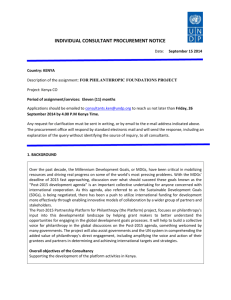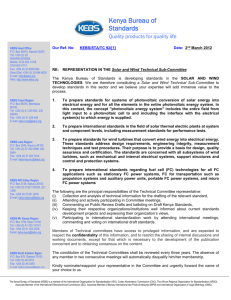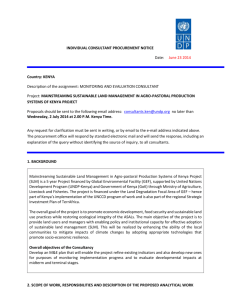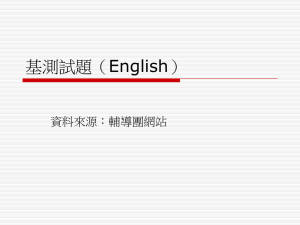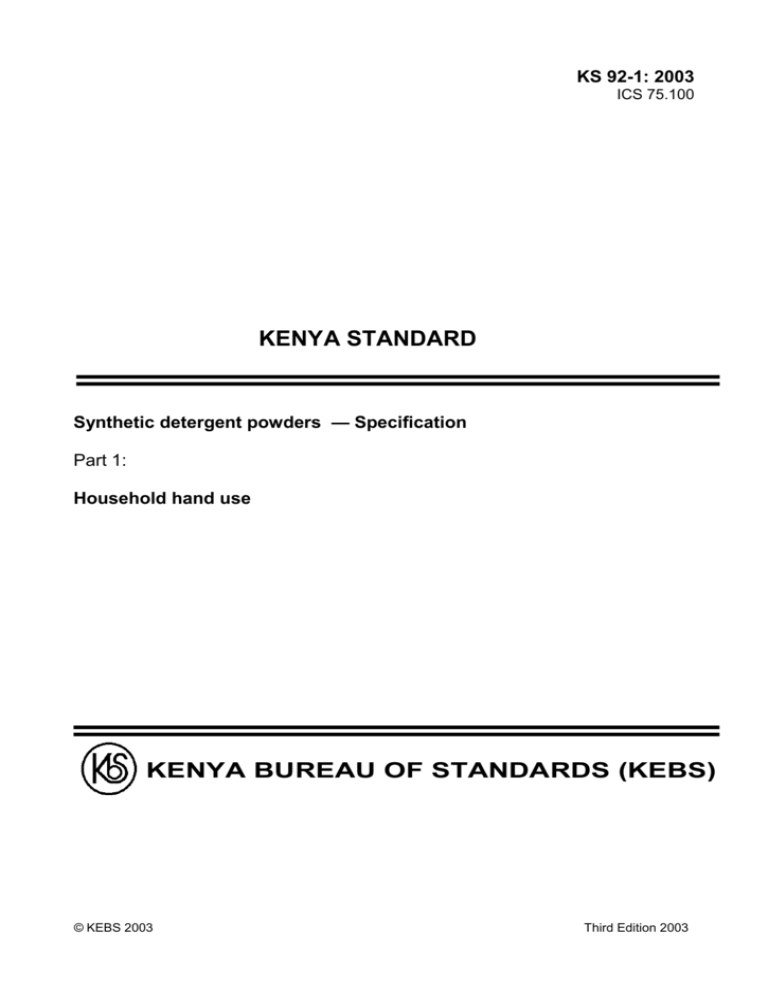
KS 92-1: 2003
ICS 75.100
KENYA STANDARD
Synthetic detergent powders — Specification
Part 1:
Household hand use
KENYA BUREAU OF STANDARDS (KEBS)
© KEBS 2003
Third Edition 2003
KS 92-1: 2003
TECHNICAL COMMITTEE REPRESENTATION
The following organizations were represented on the Technical Committee:
PZ Cussons E.A.
Nairobi City Council
Unilever Kenya Ltd.
Colgate Palmolive (E.A.) Ltd.
Kenya Industrial Research and Development Institute (KIRDI)
Government Chemist’s Department
Orbit Chemicals
University of Nairobi
Reckitt Benckiser East Africa Ltd.
Consumer Information Network
Kenya Bureau of Standards — Secretariat
REVISION OF KENYA STANDARDS
In order to keep abreast of progress in industry, Kenya Standards shall be regularly reviewed. Suggestions
for improvements to published standards, addressed to the Managing Director, Kenya Bureau of
Standards, are welcome.
© Kenya Bureau of Standards, 2003
Copyright: Users are reminded that by virtue of section 6 of the Copyright Act, Cap. 130 of the Laws of Kenya, copyright subsists in all
Kenya Standards and except as provided under section 7 of this Act, no Kenya Standard produced by Kenya Bureau of Standards may
be reproduced, stored in a retrieval system in any form or transmitted by any means without prior permission in writing from the
Managing Director.
ISBN 9966-23-368-7
KENYA BUREAU OF STANDARDS (KEBS)
Head Office: P.O. Box 54974, Nairobi-00200, Tel.: (+254 020) 605490, 602350, Fax: (+254 020) 604031
E-Mail: info@kebs.org, Web:http://www.kebs.org
Coast Regional Office
P.O. Box 99376, Mombasa-80100
Tel.: (+254 041) 229563, 230939/40
Fax: (+254 041) 229448
ii
Western Kenya Regional Office
P.O. Box 2949, Kisumu-40100
Tel.: (+254 057) 23549, 22396
Fax: (+254 057) 21814
Rift Valley Regional Office
P.O. Box 8111, Eldoret-30100
Tel.: (+254 053) 33151, 63377
Fax: (+254 053) 33150
© KEBS 2000 — All rights reserved
KS 92-1: 2003
Foreword
This Part 1 of KS 92 was revised by the Technical Committee on Soaps and Detergents under the guidance
of the Chemical Industry Standards Committee and it is in accordance with the procedures of the Bureau.
The second revision of Kenya Standard, Specification for synthetic detergent powders for household use
was initiated by the industry. It has been discovered that equally good cleaning can be achieved at relatively
low detergent levels. With the advance of technology, other equally effective and cheaper builders can be
used instead of Sodium Tripolyphosphate (STPP) which is currently being used. The standard should also
be more performance based than composition based as performance is what the consumer is interested in.
This edition has the minimum active detergent level of 12 %. The STPP level is not specified but a list of
approved builders and additives is included in the Annex A. In order for the standard to be performance
based, a cleaning efficiency test method is included.
This third edition emphasizes on the biodegradability of the surfactants used to manufacture detergent
powders and a method for determining the same has been developed.
During the revision of this standard, reference was also made to the South African Bureau of Standards
Method 1082, Cleaning efficiency test method for laundry detergents.
Ackowledgement is hereby made from the assistance derived from the above source.
© KEBS 2003 — All rights reserved
iii
KENYA STANDARD
KS 92-1: 2003
Synthetic detergent powders — Specification
Part 1:
Household hand use
1
Scope
This Part 1 of KS 92 prescribes the requirements and methods of test for synthetic detergent powders for
household use, based predominantly on the use of alkyl aryl sulphonates.
This Kenya Standard covers hand-washing powders only and does not cover machine wash detergents.
2
Requirements
2.1
Description
The active ingredients used may include, besides salt of alkyl aryl sulphonic acid, soap and non-ionics.
The active ingredient used must be biodegradable when tested against KS 92-31).
The formulation may contain one or more of the builders or additives given in Annex A.
The material shall be a free flowing powder.
The material shall also comply with the requirements given in Table 1 when tested in accordance with the
corresponding test method.
Table 1— Requirements for synthetic detergent powders — Household hand use
SL No
Characteristic
Requirement
Test method
i)
Active ingredient, % m/m, min.
12.0
Annex B
ii)
Moisture and volatile matter content
at 105 °C, % m/m, max.
18.0
Annex C
iii)
Matter insoluble in alcohol, % m/m,
max.
90.0
Annex D
iv)
pH of 1 % solution (m/v) at 23 2 °C
9 to 11
Annex E
v)
Non-detergent organic matter
(NDOM), % m/m, max.
Cleaning efficiency
2.0
Annex F
To pass test
Annex G
vi)
3
Packaging and marking
3.1
Packing
The material shall be supplied in suitable well-closed containers.
3.2
Marking
Determination of biodegradability of surfactants —Test Method.
© KEBS 2003 — All rights reserved
1)
1
KS 92-1: 2003
The container shall be securely closed and marked legibly with the following information:
a)
manufacturer’s name and address and/or registered trade mark if any.
b)
Product name.
c)
Batch or code number.
d)
Net weight in grams.
e)
Country of origin.
f)
Instructions for use.
4
Tests
Tests shall be carried out as prescribed in Annexes B to G. Due to the fact that detergent powder can
absorb or lose moisture during storage, the analytical results found on samples in open markets shall be
calculated to the original weight found out at the sampling stage, i.e.
Actual weight x moisture determined
specified weight
Unless otherwise specified, chemicals of analytical grades and distilled water shall be used in tests.
2
© KEBS 2003 — All rights reserved
KS 92-1: 2003
Annex A
(Normative)
List of suggested builders and additives
Sodium carbonate
Sodium sulphate
Sodium carboxymethyl cellulose
Sodium silicate
Optical brighteners
Lather boosters
Hydrotropes
Perfume
Preservatives
Chelating agents (sequestering agents)
Colourants
Perborates
Enzymes
Bactericides
Common salt
Urea
Magnesium sulphate
Sodium tripolyphosphate (STPP)
Zeolites
Any other internationally accepted builder cleared by the Kenya Bureau of Standards.
© KEBS 2003 — All rights reserved
3
KS 92-1: 2003
Annex B
(Normative)
Determination of active ingredient
B.1
Principle
Active matter, namely, the sodium salt of sulphonated alkyl benzene, shall first be separated from inorganic
Salt and non-detergent organic matter. It shall then be neutralized with ethyl alcohol, dried and weighed.
Finally the weighed extract shall be corrected for the presence of sodium chloride and alkali carbonates.
B.2
Apparatus
B.2.1 Beakers
150 mL and 100 mL capacity.
B.2.2 Buchner flask
500 mL capacity fitted with a sintered glass filter funnel.
B.2.3
Evaporating basin
B.2.4 Separating funnels
100 mL capacity.
B.2.5
Steam bath
B.2.6 Wide-mouthed flat-bottomed flask
200 mL capacity.
B.2.7 Air-oven
Preferably electrically heated, with temperature control device.
B.3
Reagents
B.3.1 Ethyl alcohol
30 per cent, 96 per cent and absolute (by volume).
B.3.2
Diethyl ether
B.3.3
Acetone
B.3.4 Standard sulphuric acid
Approximately 0.1N.
B.3.5 Standard silver nitrate solution
0.1N.
B.3.6 Phenolphthalein indicator
1 per cent solution in 95 per cent (by volume) ethyl alcohol.
B.3.7 Methyl orange indicator
0.1 per cent (m/v).
B.3.8 Nitric acid
Concentrated, sp. gravity 1.42.
B.3.9
4
Nitro-benzene.
© KEBS 2003 — All rights reserved
KS 92-1: 2003
B.3.10 Standard ammonium thiocyanate solution
Approximately 0.1N.
B.3.11 Ferric ammonium sulphate indicator
Saturated solution.
B.3.12 Caustic soda solution
10 per cent (m/v).
B.4
Procedure
B.4.1 Removal of inorganic salts
Weigh accurately about 5 g of the material for products containing about 20 % active matter, and
correspondingly less for products of higher active matter content. Proceed as described in the determination
of matter insoluble in alcohol (Annex D). After filtering and washing the residue thoroughly with hot ethyl
alcohol, evaporate the combined filtrate to a small bulk in an evaporating basin.
B.4.2
Determination of active matter
B.4.2.1 To ensure that the residue is completely anhydrous, add 300 mL of absolute alcohol and evaporate
to dryness. Extract the residue with 30 mL of hot 96 % ethyl alcohol, stirring and breaking up the solid matter
in the dish with a glass rod. Allow the solid matter to settle and decant the hot alcoholic solution through a
sintered glass filter funnel fitted to a Buchner flask to which suction is applied. Extract the residue in the dish
with six further consecutive 30 mL portions of hot 96 per cent ethyl alcohol. Pass each extract in turn through
the sintered glass filter. Finally wash the residue in the sintered glass filter three times with about 20 mL of
96 per cent ethyl alcohol from the jet of a wash bottle.
B.4.2.2 Transfer the filtrate and washings in the Buchner flask to a tared wide-mouthed flat-bottomed flask,
evaporate nearly to dryness on a water bath, and drive off the remaining solvent by directing a gentle stream
of dry air into the flask whilst continuously rotating the latter on the water bath. A thin film of active matter
easy to dry is thereby obtained. Add 10 mL of acetone, evaporate and remove the last traces of solvent as
described above, cool in a desiccator and weigh.
B.4.2.3 Heat the flask for not more than five minutes in an air-oven at a temperature of 100 1°C, gently
blow out with a current of air, cool and re- weigh. Repeat this drying process until the difference between two
successive weighings does not exceed 3 mg. Record this weight as M 1.
B.4.2.5 The extract obtained in B.4.2.4 contains the active matter, some sodium chloride and possibly a
trace of alkali carbonates, which may have passed through the filter in the presence of the detergent.
B.4.3
Determination of alkali carbonates
B.4.3.1 Dissolve the extract in B.4.2.4 in cold distilled water, add a few drops of methyl orange indicator and
titrate with standard sulphuric acid to the methyl orange endpoint.
B.4.3.2 Calculation
Mass in g of sodium carbonate,
M2 = 0.053 VN
where
V = Volume in ml of standard sulphuric acid used and,
N = Normality of the standard sulphuric acid solution.
B.4.3.3 Reserve the solution for the estimation of chlorides.
B.4.4
Determination of chlorides
B.4.4.1 To the solution remaining after the estimation of alkali carbonates, add 2 mL of concentrated nitric
acid and 20 mL of standard silver nitrate solution. Add 3 mL of nitrobenzene and shake vigorously. Titrate
with standard ammonium thiocyanate solution using ferric aluminium sulphate as indicator.
© KEBS 2003 — All rights reserved
5
KS 92-1: 2003
B.4.4.2 Calculation
Mass in g of sodium chloride,
M3 = 0.058 (20N – VN1)
where,
N = normality of the standard silver nitrate solution;
V = volume in ml of standard ammonium thiocyanate used;
N1 = normality of the standard ammonium thiocyanate solution.
B.4.4.3
Calculation
Active matter, per cent by mass
= 100
(m 0
m2 m3 )
m
where,
m1
m2
m3
m
6
=
=
=
=
is the mass in g of alcohol extract (see B.4.2.4);
is the mass in g of sodium carbonate (see B.4.3.2);
is the mass in g of sodium chloride (see B.4.4.2);
is the mass in g of the material taken for the test.
© KEBS 2003 — All rights reserved
KS 92-1: 2003
Annex C
(Normative)
Determination of moisture and volatile matter content
C.1
Principle
Moisture and volatile matter is determined by oven method.
C.2
Apparatus
C.2.1 Porcelain or silica dish
6 cm to 8 cm in diameter and 2 cm to 4 cm in depth.
C.2.2 Desiccator
Containing an efficient desiccant, such as phosphorus pentoxide.
C.2.3
Air-oven, preferably electrically heated, with temperature control device.
C.3
Procedure
Weigh accurately about 5 g of the material into a dry tarred dish, and dry to constant mass in air-oven at a
temperature of 105 1C. Cool in a desiccator and weigh. Constant mass shall be considered to have been
attained when successive heating for one-hour period shows a difference of not more than 5 mg in the net
loss in mass.
C.4
Calculation
Moisture and volatile matter content (at 1050C), per cent by mass
=
m0
m1
m0
100
where
m0 = mass in g of the material taken for test, and
m1 = mass in g of the material upon drying.
© KEBS 2003 — All rights reserved
7
KS 92-1: 2003
Annex D
(Normative)
Determination of matter insoluble in alcohol
D.1
Principle of method
Matter insoluble in alcohol, generally means the inorganic salts, such as phosphates, sulphates, silicates and
carbonates which are usually present in non-soapy detergent preparations. These can be separated from
active matter, non-detergent organic matter, e.t.c by extracting the material with 96 per cent ethyl alcohol.
D.2
Apparatus
D.2.1 Beaker
150 mL capacity.
D.2.2
Steam bath
D.2.3 Buchner flask
500 mL capacity, fitted with sintered glass filter funnel.
D.2.4 Air-oven
Preferably electrically heated, with temperature control device.
D.3
Reagents
D.3.1 Ethyl alcohol
Freshly boiled, 96 per cent or higher (by volume).
D.4
Procedure
D.4.1 Weigh accurately about 5 g of the material into a beaker, and digest with 50 mL of Ethyl alcohol by
heating on a steam bath for about 2 minutes. Stir and break up any hard lump with a glass rod flattened at
one end. Allow the solid matter to settle and decant the hot alcoholic solution through a sintered glass filter
funnel fitted to a buchner flask to which suction is applied. Repeat the alcoholic digestion in a similar manner
with five further consecutive 30 mL portions of boiling ethyl alcohol. Filter each extract in turn through the
same sintered glass funnel and, finally, wash the residue several times with hot ethyl alcohol to remove all
the alcohol soluble matter.
Dry the sintered glass funnel with the residue in an air-oven at a temperature of 105 2°C until a constant
weight is obtained.
D.4.2 Even after digestion with five 30 mL portions of boiling ethyl alcohol, the alcohol insoluble portion
may sometimes be found to be sticky. In that case treat it further with more boiling ethyl alcohol until it is free
from active matter and the alcohol insoluble portion is no longer sticky.
D.4.3
Calculation
Matter insoluble in alcohol, per cent by mass =
100 m0
m1
Where,
mo = in grams of matter insoluble in alcohol, and
m1 = in grams of material taken for the test.
8
© KEBS 2003 — All rights reserved
KS 92-1: 2003
Annex E
(Normative)
Determination of hydrogen ion concentration
E.1
General
pH determination shall be made in acid free atmosphere.
E.2.1 pH meter
Any standard electrometric instrument, equipped with a low sodium error glass electrode. The instrument
shall be calibrated and standardized with standard buffer solution before use.
E.2.2
Volumetric flask –100 mL capacity.
E.3
Reagents
E.3.1 Distilled water
Distilled water shall be boiled thoroughly or purged with carbon dioxide free air to remove carbon dioxide,
and shall be protected with soda lime or soda asbestos while cooling and in storage. The pH of this water
shall be between 6.2 and 7.2 at 30°C. The residue on evaporation when heated at 105°C for one hour shall
not exceed 0.5 mg per litre.
E.3.2 Standard buffer solution
Any two suitable buffer solutions within the pH range of 9 to 11 at 30°C for calibrating the pH meter.
E.3.3 Procedure
Weigh 10 0.001 g material and transfer to a 1 litre volumetric flask. Partially fill the flask with distilled water
and agitate until the sale is completely dissolved. Adjust the temperature of the solution and the distilled
water to 30 0.50C, and fill to the calibration mark with distilled water. Stopper the flask, mix thoroughly, and
allow the solution to stand at a temperature of 30°C for two hours prior to measuring the pH. Measure the pH
of the solution using a glass electrode.
© KEBS 2003 — All rights reserved
9
KS 92-1: 2003
Annex F
(Normative)
Determination of non-detergent organic matter (NDOM)
F .1
Principle of the method
The term ‘non-detergent organic matter’ includes hydrocarbons, fatty alcohols and perfumes. Using
petroleum ether and under the conditions prescribed, non- detergent organic matter only is extracted leaving
any alkylamide present in the material.
F.2
Apparatus
F.2.1 Evaporating basin
Wide-mouthed flat-bottomed flask, 200 mL capacity, fitted with a sintered glass filter funnel porosite.
F.3
Reagents
F.3.1 Ethyl alcohol
50 per cent and 96 per cent (by volume).
F.3.2 Petroleum ether
Boiling range 40 C to 60 C, non-volatile residue at 80° C, maximum 0.001 %.
F.3.3 Acetone
Non volatile residue at 80 °C, maximum 0.001 %.
F.4
Procedure
F.4.1 Removal of inorganic salts
Proceed as in D.4.1.
F.4.2 Transfer quantitatively all the combined filtrate from the Buchner flask in D.4.1 to a 1 litre separating
funnel. Rinse the flask four times with 40 mL quantities of distilled water, transferring each wash in turn to the
separating funnel. Add 100 mL of petroleum ether, swirl gently to ensure adequate mixing and allow the two
phases to separate. Run off the aqueous alcoholic layer into the second separating funnel, and extract with
75 mL of petroleum ether. Combine the three ether extracts in the first separating funnel. Rinse each of the
two empty funnels with a few millilitres of petroleum ether and add the rinsings to the combined ether
extracts.
F.4.3 Wash the combined either extracts and rinsing (F.4.2) with four successive 50 mL portions of 70 per
cent ethyl alcohol, shaking and removing the alcoholic phase each time. Transfer the ether layer in stages to
a tarred flask and evaporate off the solvent. Rotate the flaks on a steam bath during the operation. Cool the
flask to about 60 °C to 65 °C, gently blow out the last traces of solvent with a current of dry air, cool in a
desiccator and weigh.
F.5
Calculation
Non-detergent organic matter, per cent by mass,
=
100m0
m1
where
m0 = the mass in g of the non-detergent organic matter in the flask, and
m1 = the mass in g of the material taken for the test.
10
© KEBS 2003 — All rights reserved
KS 92-1: 2003
Annex G
(Normative)
Determination of cleaning efficiency
G.1
Apparatus
G.1.1
Washing device
A suitable mechanical washing device capable of maintaining the contents of each of its four containers at
23 2 °C and of causing oscillating agitation of the contents of each container at a speed of 100 2 cycles
per minute.
G.1.2 Steam iron
A hand-or power-operated steam iron that is suitable for pressing and drying cotton fabrics.
G.1.3 Reflectance meter
A photo-electric reflectance meter (densitometer) capable of measuring the whiteness of a fabric.
G.2
Materials and reagents
G.2.1. Standard test clothes
G.2.1.1 Presoiled test swatches, sensitive to general detergent supplied by: The Center for Test Materials,
Marketing and Development, Stoomloggerweg 11, 3133 Kt Vlaardingen, HOLLAND.
G.2.1.2 Unsoiled test swatches made by the same manufacturer above.
G.2.2 Standard hard water
Dissolve in separate 1 litre volume of distilled water, 3.520 g of chemically pure Calcium chloride
(CaCI2.2H2O) and 3.947 g of chemically pure magnesium sulphate (MgSO 4.7H2O). Mix both of the solutions
together and dilute to 20 litres with distilled water. (This standard has a hardness of approximately 300 mg
11 or 300 ppm, expressed as calcium carbonate).
G.2.3 Blotting paper
Pieces of blotting paper of size approximately 110 mm x 40 mm.
G.2.4 Standard detergent
A detergent prepared by dissolving each of the following ingredients:
12 per cent active ingredient,
12 per cent P2O5 as STPP,
0.5 per cent sodium carboxymethl cellulose, and whose 1 per cent solution, m/v, lies between a pH of 9 and
11.
G.3
Procedure
G.3.1 Take 10 of the soiled test swatches and cut each one into four smaller swatches of size 95 mm x
72.5 mm. Cut up the unsoiled test swatch in the same way.
G.3.2 With indelible marking ink, uniquely identify as a pair, each small swatch cut from each end of a
soiled test swatch, e.g. 1 and 1a, 2 and 2a, 3 and 3a, 4 and 4a, etc. Divide the swatches into two sets, each
consisting of swatches cut from the same diagonal opposite positions e.g. 1, 2a, 3, 4a, and 1a, 2, 3a, 4, Use
one set as standard swathes and the other as sample swatches.
G.3.3 Using the reflectance meter, take four reflectance readings on each side of each soiled swatch in
turn. Take the readings with the swatch under test superimposed on three unwashed soiled test swatches
placed on the black enamel standard. Calculate both the mean reflectance of each swatch from the relevant
8 readings and the standard deviation ( ) of the 40 swatches. If the standard deviation does not exceed
© KEBS 2003 — All rights reserved
11
KS 92-1: 2003
0.80, proceeds in G.3.6.
G.3.4 If, however, the standard deviation exceeds 0.80, remove and discard the pair(s) or swatches, which
have the highest or lowest (or both, as appropriate) reflectance readings and replace each discarded pair
with a new pair of swatches. Determine, as in G.3.4, the mean reflectance of each replacement and calculate
the new standard deviation. Repeat this procedure until the standard deviation of the 40 swatches does not
exceed 0.80.
G.3.5
Start the washing device and set it to a wash temperature of 25 ± 1°C.
G.3.6 Weigh out 5.0 g of the standard detergent into a 5 L beaker and add 3 litres of the standard hard
water.
G.3.7 Weight out 5.00 g of the detergent under test into a 5 L beaker and add 3 litres of the standard hard
water.
NOTE:
Prepare these solutions sufficiently early to allow the standard and test sample to be completely dissolved when the test is
started.
G.3.8 Place both of the solutions on a warm or in a water bath 1 hour before use and, timing occasionally,
bring their temperatures to 25 + 1°C, and then maintain them at this temperature until the test is started.
G.3.9 Mix the standard solution thoroughly and immediately thereafter, using a measuring cylinder, transfer
1 000 mL of the solution to a container of the washing device. Mix the remaining solution thoroughly and in
the same way transfer 1 000 mL of the solution into another container.
G.3.10 Repeat the procedure given in G.3.9 but use the sample solution.
G.3.11 Bring the temperature of the solutions in the containers back to 25 ± 1°C, and then, by sliding, each
swatch down the side of the container until it is below the surface of the solution, add 10 standard swatches
to each of two containers of standard solution, and 10 sample swatches to each of the other two containers.
Wash at a speed of 100 2 cycles per minute for exactly 10 min, then stop the machine, examine the
swatches in each container and separate any that have become entangled. Wash for a further 20-min.
G.3.12 After washing, remove the swatches from the wash solution and without squeezing, blot each swatch
separately between pieces of the dry blotting paper, then rinse, for 1 min. All the swatches together in
approximately 4 litres of the standard hard water at a temperature of 25 3°C, stirring with a glass rod during
the rinsing. Remove the swatches from the water and, without squeezing, blot each swatch separately
between pieces of the dry blotting paper.
G.3.13 Steam iron the blotted swatches and condition them at ambient temperature for at least 1 hour.
G.3.14 Determine the mean reflectance of each of the washed swatches as in G.3.4. but instead of three
unwashed swatches, place three washed swatches on the black enamel standard.
G.3.15 Determine as in G.3.4, the mean reflectance of one swatch of the unsoiled test cloth (see G.3.2),
using the other three swatches of the unsoiled test cloth as the backing.
G.4
Calculations
G.4.1
Calculate the cleaning efficiency, expressed as percentage soil removal, of each swatch as follows:
CE =
R2 R1
100
R0 R1
where,
R1 = the mean reflectance of the soiled test cloth swatch before washing;
R2 = the mean reflectance of the soiled test cloth swatch after washing;
R0 = the mean reflectance of the unsoiled test cloth.
12
© KEBS 2003 — All rights reserved

